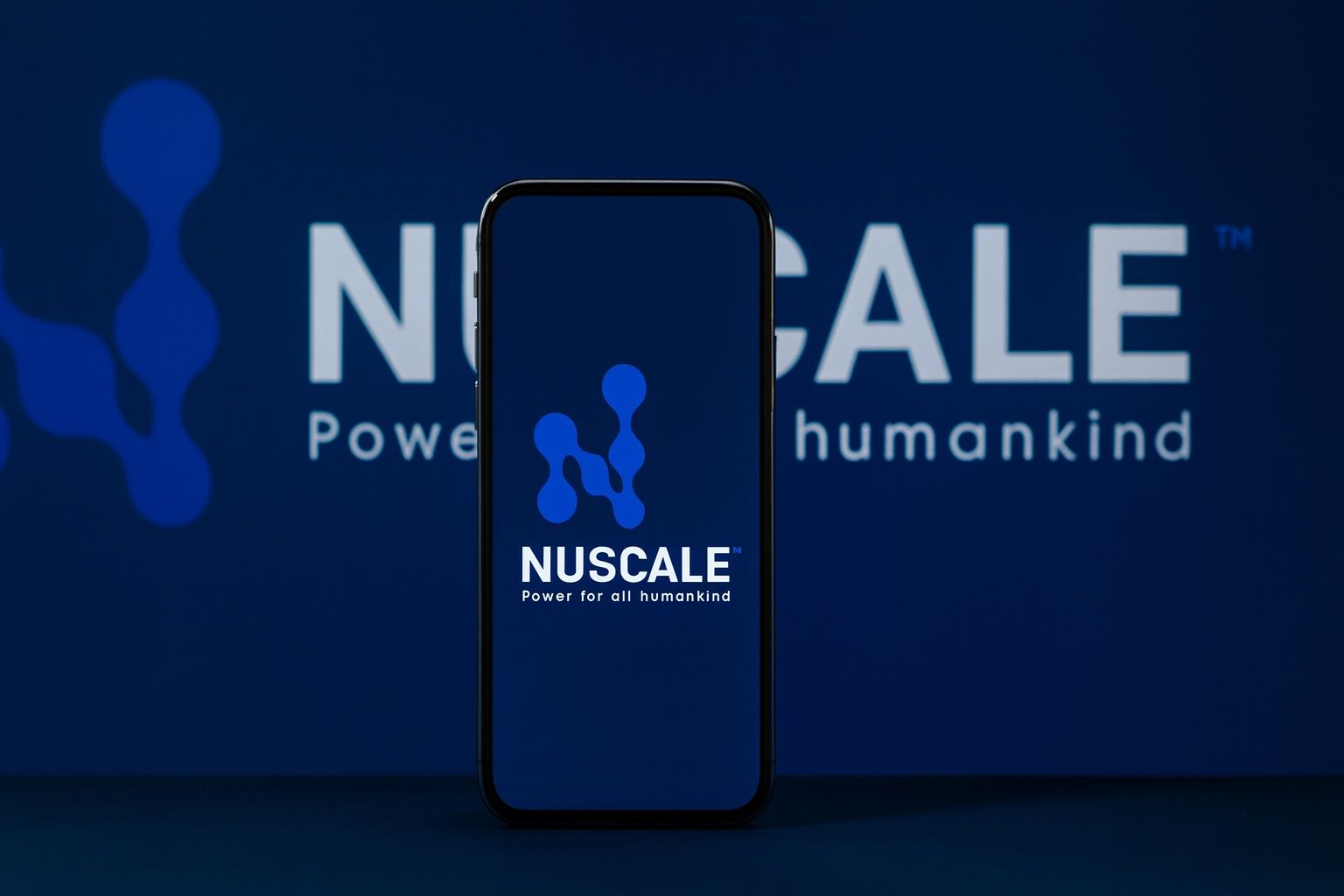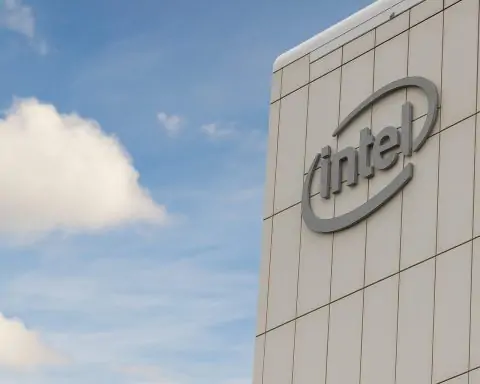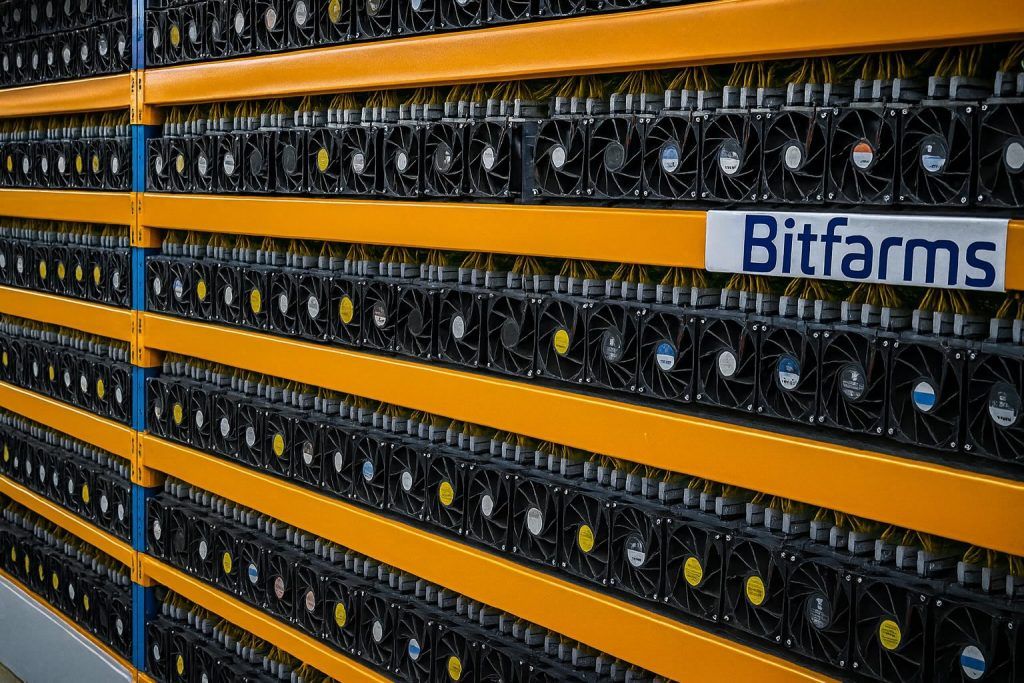- Ticker & Price: NuScale Power (NYSE: SMR) is trading around $45 as of mid-October 2025 [1], up dramatically from its $10 IPO price in May 2022 [2]. The stock briefly spiked to ~$46.40 on October 13, 2025 [3].
- Market Cap & Range: Market capitalization is roughly $12–13 billion [4] [5]. The 52-week range has been about $11.08 (low) to $53.50 (high) [6], reflecting a ~300%+ rise since 2022 [7] [8].
- Recent Rally: On October 13, NuScale shares jumped 14.3% intraday [9] on heavy volume. Over one year the stock is up nearly 200% [10], and about 119% year-to-date [11].
- Analysts & Targets: Wall Street consensus is mixed. About 3 analysts rate SMR “Buy,” 10 “Hold” and 2 “Sell,” for an overall Hold rating and median 12-month target around $37–$40 [12] [13]. TradingView’s consensus target is ~$42.75 [14]. Price targets range widely ($28–$60) [15] [16].
- Insiders & Institutions: Fluor Corp (NuScale’s majority owner) sold 15 million shares (net $605M) in early October 2025 [17]. Fluor still owns ~39% of SMR [18]. Recent SEC filings show insider selling – e.g. a Fluor director sold 2.37M shares (~19% of their stake) for ~$104M in September [19]. Institutional investors own ~78% [20].
- Technology & Deployment: NuScale’s core product is a small modular reactor (SMR) — a factory-built pressurized-water reactor generating 77 MWe each, scalable to dozens of reactors (up to ~924 MWe total) [21] [22]. In May 2025, the U.S. Nuclear Regulatory Commission approved NuScale’s uprated 77 MWe design – making it the first (and so far only) SMR design certified in the U.S. [23] [24]. NuScale targets initial plant deployments by around 2030 [25] [26].
- Major Projects: In Sept 2025, NuScale/partner ENTRA1 inked a landmark $6 GW SMR deployment program with the Tennessee Valley Authority (TVA) [27] [28]. This is “the largest SMR deployment in U.S. history,” expected to power the equivalent of millions of homes and dozens of AI data centers [29] [30]. Other deals include Standard Power’s planned ~2 GW NuScale data-center projects in Ohio and Pennsylvania [31] [32], and partnerships with technology suppliers like Paragon [33] [34].
Recent News and Stock Momentum
In the week of October 13, 2025 NuScale Power made headlines. On Oct 9, Fluor Corporation (NuScale’s original parent) announced it sold 15 million SMR Class A shares for ~$605 million [35]. Fluor said it will use proceeds to fund stock buybacks and still holds Class B shares representing ~39% equity [36]. This partial divestment drew investor attention and scrutiny. On Oct 12, Simply Wall St reported on these events and NuScale’s record TVA/ENTRA1 6 GW SMR agreement [37].
The next day (Oct 13) NuScale’s stock soared ~14%, trading as high as $46.40 [38] before settling near $44.84 by mid-session. Volume spiked to ~30 million shares [39], compared to the prior close of $39.24. MarketBeat noted the jump and heavy trading, citing analyst commentary (Weiss, UBS, Barclays, etc.) and revision of targets [40] [41]. For context, SMR’s 50-day average price was ~$37.96 [42] and 200-day ~$32.42 [43], so the stock is riding a strong upward trend.
This rally reflects a mix of factors: high-profile deals (like the TVA SMR program), optimistic industry outlook, and speculative buying. It comes amid broader market excitement over nuclear energy’s role in powering AI and data centers [44] [45]. The surge was, however, followed by some profit-taking: by Oct 14, the stock is off slightly (trading around $45.02 [46]) but well above late-2024 levels.
Technology, Regulatory Milestones, and Projects
NuScale’s SMR technology is a conventional light-water nuclear reactor, optimized for modular factory construction. Each NuScale Power Module™ is a small pressurized-water reactor producing 77 MWe (about 250 MWth) [47]. Modules are designed to be built off-site and “stacked” – a full plant may have 1 to 12 modules (up to ~924 MWe) [48] [49]. NuScale emphasizes passive safety features (cooling by gravity and convection) and use of standard low-enriched uranium fuel [50] [51].
Crucially, NuScale’s designs have regulatory approval. In May 2025 the U.S. Nuclear Regulatory Commission (NRC) granted Design Approval for NuScale’s uprated 77 MWe design [52]. That made NuScale “the first and only SMR technology company to have received approval” from the NRC [53]. NuScale CEO John Hopkins hailed this as a “historic moment” and a key step toward providing “clean, reliable, and, most importantly, safe energy” [54]. The NRC first certified NuScale’s 50 MWe design in 2020 (the world’s first SMR certification) and later approved the power uprate to 77 MWe [55]. NuScale says it is on track to deploy its first plant by 2030 [56] [57].
In practical terms, NuScale’s SMRs target carbon-free baseload power for utilities and heavy industry. Use cases include electricity, hydrogen production, desalination, district heating, and especially data centers and AI infrastructure – which require 24/7 reliable power [58] [59]. For example, Standard Power (a data-center infrastructure firm) has chosen NuScale SMRs for two projects supplying ~2 GW to AI-focused data farms [60] [61]. NuScale’s modular approach (factory fabrication, incremental deployment) is touted as cost-competitive and faster to build than large reactors [62] [63].
Major Partnerships and Industry Outlook
NuScale has been bolstering its projects via partnerships. Its ENTRA1 Energy joint venture (formed 2022) is commercializing NuScale plants. In September 2025, NuScale announced support for ENTRA1’s TVA deal: an agreement to build up to six NuScale SMRs (77 MW each) in TVA’s service area [64] [65]. This program (potentially ~6 GW capacity) is “the largest SMR deployment in U.S. history,” and aims to power the equivalent of ~4.5 million homes or ~60 new data centers [66] [67]. John Hopkins emphasized that this partnership will “meet America’s surging demand for reliable, carbon-free baseload power — powering AI data centers, [and] critical industries” [68]. Skip Alvarado of ENTRA1 added that energy security is vital for the U.S. economy (“dependable electricity is the lifeblood of America’s future”) [69].
NuScale is also working with industrial partners. For example, Paragon Energy Solutions (a nuclear instrumentation firm) agreed to supply key monitoring and protection systems for NuScale’s SMRs [70] [71]. Paragon’s CEO praised NuScale as “a market leader in the nuclear industry” and lauded the two companies’ aligned mission to bring innovative technology to the growing SMR market [72]. NuScale’s John Hopkins said the partnership ensures “we are delivering power that is not only clean and reliable, but most importantly, safe” as NuScale prepares for “near-term deployment” [73].
Beyond the U.S., NuScale and ENTRA1 have international ambitions (e.g. an ongoing project in Romania). However, the U.S. market remains key: a recent industry analysis notes that utilities are embracing advanced nuclear (fission and even fusion) to meet booming demand, especially from data centers [74]. TVA’s dual strategy (SMRs + fusion) illustrates confidence in nuclear’s role. Utilities see SMRs as crucial to provide round-the-clock carbon-free power in the AI era [75].
Expert Opinions and Analyst Commentary
Industry experts have mixed views. NuScale’s executives and partners speak positively. CEO John Hopkins calls NuScale’s SMR “proven technology” that helps meet decarbonization goals [76]. He notes NuScale’s factory-built design keeps costs “low, consistent and predictable,” making it cheaper to build and operate than traditional reactors [77]. ENTRA1 and utility leaders emphasize energy security: ENTRA1’s Alvarado said “Energy security is national security” and stressed SMRs’ role in powering AI and manufacturing [78]. Data-center proponents also back SMRs: Standard Power’s CEO noted that as legacy plants retire and AI demand grows, NuScale’s SMRs can deliver carbon-free baseload energy to fill that gap [79]. Even tech giants are getting involved: Alphabet/Google’s CFO Ruth Porat has publicly urged that “nuclear has to be a part of the mix” to meet future energy needs [80].
However, some analysts urge caution. A March 2025 Reuters analysis highlighted that SMR projects still face cost overruns and regulatory hurdles [81] [82]. In fact, NuScale canceled its last demonstration project in Idaho in 2023 after costs nearly doubled [83]. CEO Hopkins has acknowledged (in earnings calls) that NuScale has not yet secured any U.S. data-center customers, underscoring that contracts must still materialize [84]. Industry consultant Jeffrey Bonner warns that the first SMR providers will have an advantage only if they can “build out the [fuel] supply chain” – adding that SMRs will be “very expensive initially” until the infrastructure is established [85].
On Wall Street, analysts are somewhat bullish but tempered. Recent ratings are mixed: for example, Barclays initiated coverage with an “Equal-Weight” rating and $45 target, BNP Paribas and UBS have “Hold/Neutral” ratings around ~$38–$41, while Canaccord remains aggressive (“Buy,” target up to $60) [86] [87]. MarketBeat notes the consensus as a Hold with average target ~$36.67 [88] [89]. TickerNerd reports a median analyst target of $40 (range $28–$60) based on 15 forecasts [90], implying only minor upside from current levels. TradingView likewise shows a $42.75 consensus target with a consensus “Buy” rating [91] [92]. In short, analysts recognize NuScale’s unique position, but most see limited near-term upside at current prices.
Investment Outlook, Forecasts & Risks
NuScale’s stock forecasts vary. Many models expect only moderate gains: a mid-$30s to ~$40 fair value is common [93] [94], with upside potential tied to closing large deals and project execution. Simply Wall St (Oct 2025) projects revenues of ~$402M by 2028, reaching breakeven profit around 2030, but warns of tight margins until then [95].
The broader SMR sector’s growth prospects are strong: market research firms estimate the global SMR market could grow from a few billion in 2025 to ~$15–20B by 2030 [96], fueled by carbon reduction goals and AI-driven power demand. U.S. policy is also supportive – the 2025 Energy Act extended nuclear tax credits and directed regulators to speed reviews, and utilities have signed major contracts [97] [98].
Yet significant risks remain. SMRs are unproven at scale, and any delays or cost overruns can sink investor returns. Analysts caution that failure to secure customers (or higher-than-expected build costs) could sharply undercut NuScale’s valuation [99] [100]. The first SMRs will likely be more expensive than conventional plants until learning and supply chains improve. Geopolitical or policy shifts could also impact nuclear incentives. In short, while experts agree NuScale is at the forefront of the SMR revolution, many urge patience. The stock’s recent rally reflects optimism about future growth, but its price assumes that NuScale can execute flawlessly on its $multi-billion contracts and rapidly scale production [101] [102].
Sources: Author’s analysis of NuScale corporate releases and filings [103] [104], financial news articles [105] [106] [107], industry reports [108] [109], and analysts’ data [110] [111].
References
1. www.investing.com, 2. newsroom.fluor.com, 3. www.marketbeat.com, 4. www.marketbeat.com, 5. www.marketbeat.com, 6. www.marketbeat.com, 7. newsroom.fluor.com, 8. tickernerd.com, 9. www.marketbeat.com, 10. tickernerd.com, 11. tickernerd.com, 12. www.marketbeat.com, 13. tickernerd.com, 14. www.tradingview.com, 15. tickernerd.com, 16. www.tradingview.com, 17. newsroom.fluor.com, 18. newsroom.fluor.com, 19. www.marketbeat.com, 20. www.marketbeat.com, 21. www.nuscalepower.com, 22. www.nuscalepower.com, 23. ts2.tech, 24. www.nuscalepower.com, 25. ts2.tech, 26. www.nuscalepower.com, 27. www.nuscalepower.com, 28. ts2.tech, 29. www.nuscalepower.com, 30. ts2.tech, 31. www.nuscalepower.com, 32. www.nuscalepower.com, 33. paragones.com, 34. paragones.com, 35. newsroom.fluor.com, 36. newsroom.fluor.com, 37. simplywall.st, 38. www.marketbeat.com, 39. www.marketbeat.com, 40. www.marketbeat.com, 41. www.marketbeat.com, 42. www.marketbeat.com, 43. www.marketbeat.com, 44. www.nuscalepower.com, 45. ts2.tech, 46. www.investing.com, 47. www.nuscalepower.com, 48. www.nuscalepower.com, 49. www.marketbeat.com, 50. www.nuscalepower.com, 51. www.marketbeat.com, 52. www.nuscalepower.com, 53. www.nuscalepower.com, 54. www.nuscalepower.com, 55. www.nuscalepower.com, 56. ts2.tech, 57. www.nuscalepower.com, 58. www.nuscalepower.com, 59. www.nuscalepower.com, 60. www.nuscalepower.com, 61. www.nuscalepower.com, 62. www.nuscalepower.com, 63. www.nuscalepower.com, 64. www.nuscalepower.com, 65. ts2.tech, 66. www.nuscalepower.com, 67. ts2.tech, 68. www.nuscalepower.com, 69. www.nuscalepower.com, 70. paragones.com, 71. paragones.com, 72. paragones.com, 73. paragones.com, 74. ts2.tech, 75. ts2.tech, 76. www.nuscalepower.com, 77. www.nuscalepower.com, 78. www.nuscalepower.com, 79. www.nuscalepower.com, 80. www.reuters.com, 81. www.reuters.com, 82. www.reuters.com, 83. www.reuters.com, 84. www.reuters.com, 85. www.reuters.com, 86. www.marketbeat.com, 87. www.marketbeat.com, 88. www.marketbeat.com, 89. www.marketbeat.com, 90. tickernerd.com, 91. www.tradingview.com, 92. www.tradingview.com, 93. tickernerd.com, 94. www.tradingview.com, 95. simplywall.st, 96. www.nasdaq.com, 97. ts2.tech, 98. ts2.tech, 99. ts2.tech, 100. www.reuters.com, 101. ts2.tech, 102. www.nuscalepower.com, 103. newsroom.fluor.com, 104. www.nuscalepower.com, 105. www.marketbeat.com, 106. www.marketbeat.com, 107. ts2.tech, 108. ts2.tech, 109. www.reuters.com, 110. tickernerd.com, 111. www.tradingview.com







